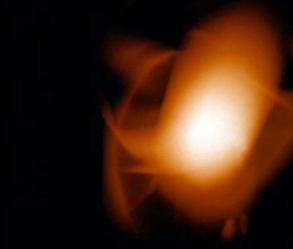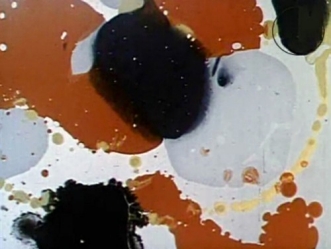Andrzej Pawłowski was a painter, sculptor, and industrial designer affiliated with the Kraków Group, a community of Kraków artists first brought together by the theater director and artist Tadeusz Kantor in 1948. Cinéforms were moving images that Pawłowski created by manipulating simple materials and screening the resulting abstract compositions with a purpose-built projector. The projector consisted of abstract models made of crumpled cellophane and paper, a system of deforming lenses, and a reflector. When Pawłowski set in motion the models and lenses, improvising to a compilation of compositions by J. S. Bach, Arthur Honegger, and music sung by Yma Sumac prepared by Jerzy Kaszycki, unique forms in a state of constant flux appeared on the screen. The spectacle of forms and light launched by the machine was a harbinger of his later idea of naturally shaped forms, manifesting Pawłowski’s belief that the most exquisite forms are created by nature and that the artist’s role consists merely in stimulating certain physical and chemical phenomena. Pawłowski first presented his work at private shows in his apartment and later shared them with a broader audience at Kantor’s Cricot 2 theater. In 1957, Cinéforms was recorded on film stock with a sound track by Adam Walaciński. What emerged was an abstract film, not far removed from non-representational painting. It was successfully exhibited at the International Experimental Film Festival Expo 58 in Brussels. — Aleksandra Kędziorek
Banner stills L to R: Somnambulists, courtesy Filmoteka Muzeum; Drawings, courtesy Vladimír Havrilla and Boris Kršňák;
Transformations: Potter's Bull, courtesy DEFA Film Library at the University of Massachusetts Amherst
Cinéforms and Somnambulists
Cinéforms (Kineformy)
Andrzej Pawłowski, Poland, 1957, 35 mm, 6 minutes 45 seconds

Still from Cinéforms, courtesy Filmoteka Muzeum
Somnambulists (Somnambulicy)
Mieczysław Waśkowski and Tadeusz Kantor, Poland, 1958, 35 mm, 8 minutes 46 seconds

Still from Somnambulists, courtesy Filmoteka Muzeum
Even though his role in this project is controversial and much debated, Somnambulists is, beyond any doubt, heavily inspired by the work of the Polish artist Tadeusz Kantor (1915–1990). One of the most influential figures in Polish culture of the 20th century, whose legacy extended years after his death in 1990, Kantor was a truly versatile figure. Through the formation of the groundbreaking Cricot 2 theater in Kraków, as well as his constant innovation in the field of visual arts, he kept alive the ethos of the prewar artistic avant-garde. Maintaining an international profile and contacts, in the 1950s and 1960s, Kantor also operated as a “liaison” between the Polish scene and the latest trends in European avant-garde art, which he observed and brought home with him from abroad, especially Paris.
In 1955, it was informel painting that fascinated him in the French capital, and he immediately started to champion it in Poland. The film Somnambulists, made by two graduates of the Film School in Łódź, director Mieczysław Waśkowski (1929–2001) and cinematographer Adam Nurzyński, marks an attempt at adding a temporal dimension to informel canvasses, thus fully visualizing the basic premise of this genre of painting—its abstract, dynamic, and incidental play of color and forms. Here, patches of color flow freely on a glass pane, translating informel into the medium of film. Somnambulists is the second work by these filmmakers devoted to Kantor’s practice (which later changed substantially). It was preceded by Attention! . . . Painting, which was made in 1957 and portrayed Kantor at work.
— Łukasz Mojsak
The organizers would like to thank Weronika Czołnowska and the Państwowa Wyższa Szkoła Filmowa, TV i Teatralna im. L. Schillera w Łodzi (The Polish National Film, Television and Theatre School in Łódź), for their help in making a screening of this film possible in Washington.
